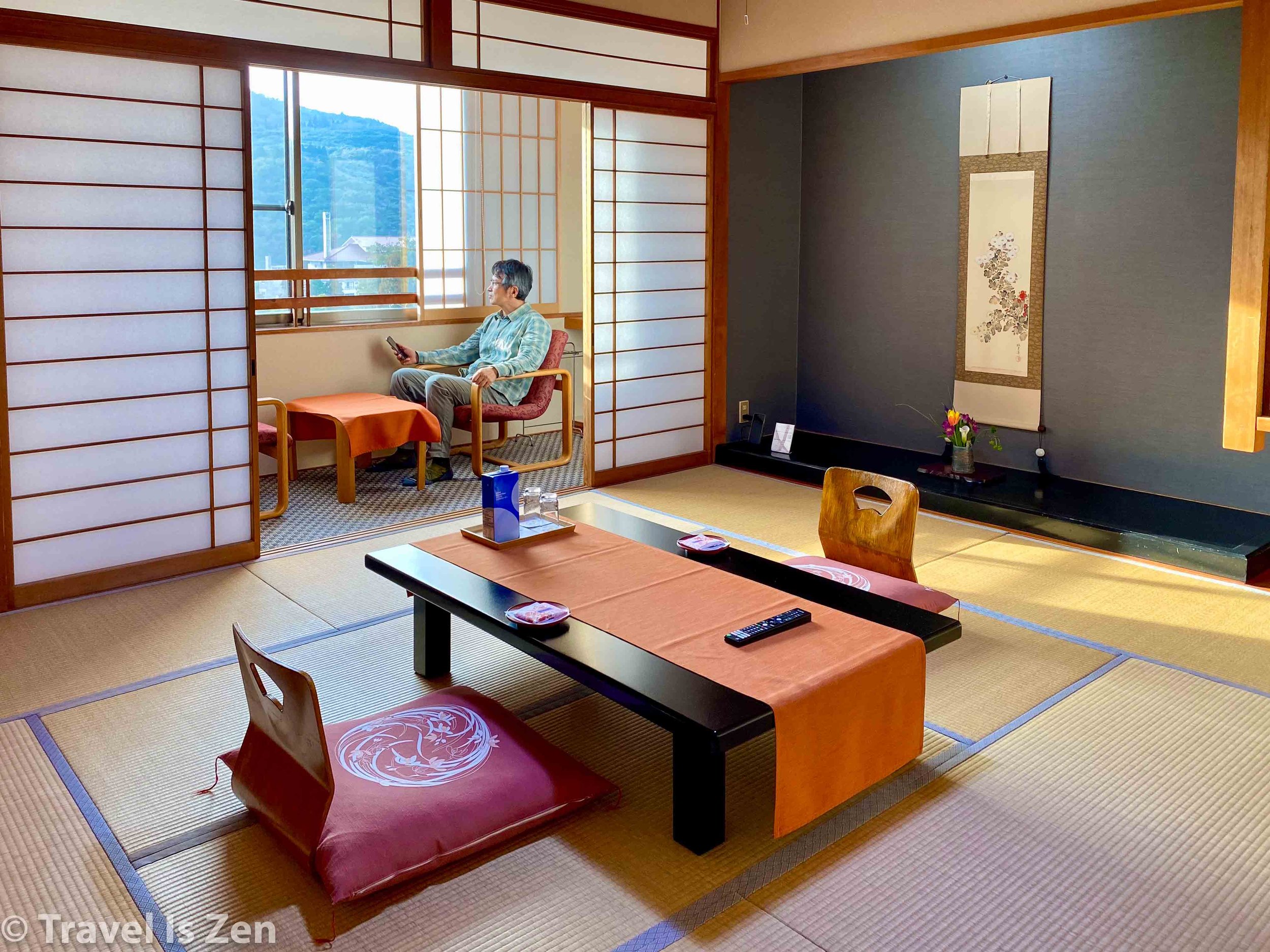The Hellish Unzen Jigoku Hot Springs, Kyushu, Japan
There’s nothing like a Japanese hot spring resort — and some aggressive hiking and site-seeing! — to warm up the body during a bitterly cold February. Traveling from Nagasaki by train, we rented a car in Shimabara and continued our 17 day roadtrip across Kyushu to Unzen National Park. From hot springs to castles to buried houses, there is so much to do in Unzen National Park!
Geothermal Spa Pampering
“Jigoku” means “hell” and the geothermal hot spring fields in Unzen do create a surreal inferno-like landscape, with warm plumes, pungent sulphur, boiling acidic pools, and gurgling fumaroles. A walkway winds through the most impressive vents. Signboards and a memorial highlight a period of Christian persecution in Kyushu in the 1600’s. Captured believers of the burgeoning Catholic movement were tossed into the hissing, boiling pools, becoming martyrs for their faith.
Click any photo for a larger slideshow…
Ryokan spa hotels in this region take full advantage of the geothermal hot springs to provide guests with luxurious pampering services, complete with multi-course, seasonal kaiseki meals. Bathe and eat - that’s the only expectation here!
We could only relax so much before it was time to earn all those kaiseki meal calories. Fortunately, there is a lot more to do in Unzen National Park than just soak in hot water. There are mountains to climb and sites to see across the peninsula.
Hiking at Fugen-dake in Unzen National Park
We were up and on the road before the sun, arriving at Nita Pass just as the first light of dawn hit the blue waters of the Ariake Sea far below. We parked near the cable car and made our way to the trailhead. Fugen-dake is an active volcano in the Mount Unzen volcanic complex. Its eruptions in the early 1990s included pyroclastic (lava and gas) flows that caused significant destruction and led to the deaths of 43 people. The eruptions forced the evacuation of thousands of residents from the nearby port town of Shimabara.
Ariake Sea and Shimabara, Nagasaki Prefecture, Kyushu Japan
Despite its turbulent history, Mount Fugen is quiet today and has become a popular hiking destination. I expected to see smoke plumes arising from the summit, but I wouldn’t get that lucky until later in the trip at Aso-Kuju National Park and Kagoshima. What made this hike special, though, was our first encounter with rime ice, which coated bushes and tree branches with a soft, white, solid powder. The higher we hiked, the thicker and denser it became, turning the landscape into a crystal wonderland.
We followed a loop-path to the summit (at 1,359 meters or 4,450 feet). On the return trip, we hooked over to Mt. Kunimi via a very steep trail - worth it for the views of the sea and Amakusa archipelago islands. There is also a small shrine and memorial to the nearly 15,000 Shimabara residents killed in a mega-tsunami in 1792. The total hike was just 5 miles, but took us nearly 5 hours as we stopped often to take photos and read information kiosks describing plants and geological features unique to the area. Total ascent was just over 2,000 feet and we had the trail almost entirely to ourselves!
Click any photo for a larger slideshow…
Site-seeing: Iwado Shrine
The following day, as a light drizzle began to fall, we drove to Iwado Shrine to the north of Mt. Fugendake. This peaceful, secluded gem is tucked into a shadowy cliffside far off the beaten path. An old stone staircase ascends to a resting pagoda set in the forest clearing; rays of light filter through pine needles. Just beyond, a prayer shrine is nestled into small caves in the cliff.
Click any photo for a larger slideshow…
With the moss and vines, the spot felt ancient and primitive. We were lucky it was raining because a small waterfall forms off the cliff, cascading into a pool and softly reverberating the gentle sound of falling water. Ahhhh, NATURE! Beautiful, hypnotizing, mezmerizing!
Obama Onsen Foot Bath and Rice Terraces
Our next stop was Obama Onsen, on the western coast of the peninsula. I’m still not quite sure how we arrived here, as our map took us down the mountain via a nameless, single-lane barely-finished, steep dirt road. Every blind turn was met with the risk of collision by an oncoming vehicle; fortunately, we encountered few! Established in the year 713, the steaming town of Obama is powered by 30 boiling hot springs, with temperatures as hot as 105°C (220°F)! The mineral-rich waters are reputed to treat all kinds of health problems, from arthritis to stomach disorders. We parked near the famous foot baths along the seashore, open to the public and free. Next to the foot baths, visitors can order a basket of steamed eggs and vegetables; unfortunately, they were sold out by the time we arrived. But the foot bath felt incredible on a chilly, rainy day, warming us up from head to toe — or, rather, toe to head.
Driving along the coastal highway, we wound through little roadside hamlets along Tachibana Bay. In Minamigushi, we turned inland and ascended to Tanabatake Observatory, with expansive views of the region’s rice terraces, ports, and the sea.
Unzen Coastal Highway, Kyushu, Japan
Shimabara (Moritake) Castle
The largest city on the peninsula is Shimabara, gateway to Unzen National Park and accessible by train from Nagasaki. A prominent landmark in the town is Shimabara Castle, also known as Moritake Castle - infamous for sparking the Shimabara Rebellion of 1637. With the Ariake Sea in front and Mt. Fugendake to its rear, the striking castle was built in 1624 by Matsukura Shigemasa, a feudal lord of the Edo period.
To pay for the construction, the Matsukura clan imposed excessive taxes on the region’s mostly-Christian peasant population, which led to a violent uprising. The rebellion sparked a persecution of Christians across Japan and enforcement of stricter isolationist policies by the Tokugawa shogunate. The original castle was destroyed after the Meiji Restoration in the mid-1800s, but rebuilt in 1964. Displays inside the museum showcase the rise of Christianity in Kyushu and the subsequent persecution of believers. Graphic drawings and paintings depict in detail the brutality inflicted upon the martyrs.
A rather strange sculpture garden lies within the boundary of the castle, as well. These “hellish” and sometimes hilarious statues are the work of Seibo Kitamura, a local artist most famous for the powerful Peace statue in Nagasaki’s Peace Park.
The symbolism of the Peace statue in Nagasaki is described as “pointing to the sky, where the bomb and death fell, his left hand stretched out in a gesture of peace. The statue’s eyes are closed in prayer for the souls of those who died. He has one leg folded in a position of meditation, the other is on the ground, prepared to stand and assist those in need.”
Shimabara Buried Houses
When Mt. Unzen erupted in the early 1990’s, massive flows of mud and ash oozed down the mountain, burying houses and farms in its path - and claiming the lives of 43 people. The Mizunashi Honjin roadside park in Shimabara preserves a small neighborhood of those buried homes as a memorial, with educational displays about volcanoes and disaster prevention.
It was our last excursion of the day in Shimabara before heading back to the ryokan near Unzen Jigoku for more bath-time and kaiseki. The following day, we left Unzen National park on the ferry, continuing our 17-day Kyushu roadtrip eastward. Time for kaiseki and hot springs in Yufuin and Beppu…
Click any photo for a larger slideshow…


















































































